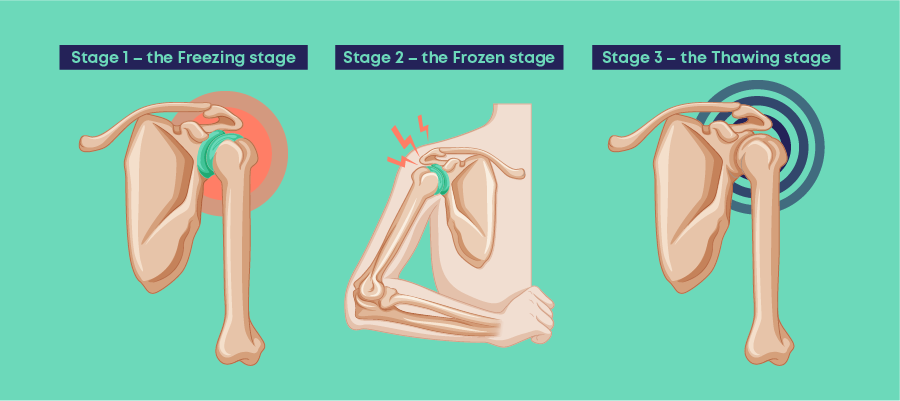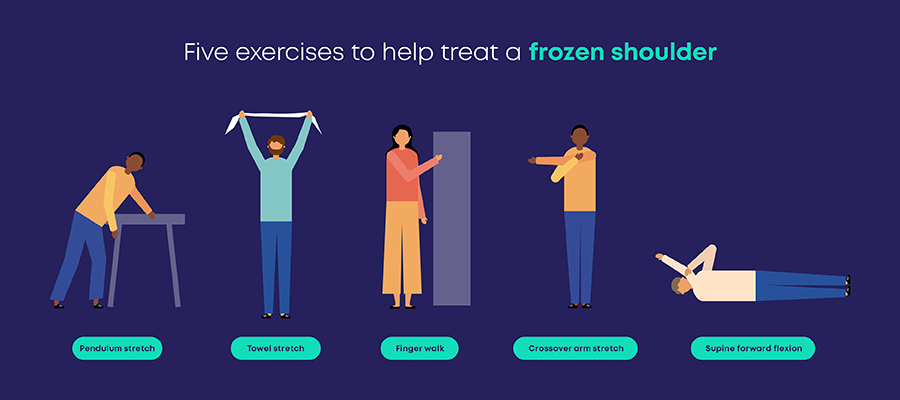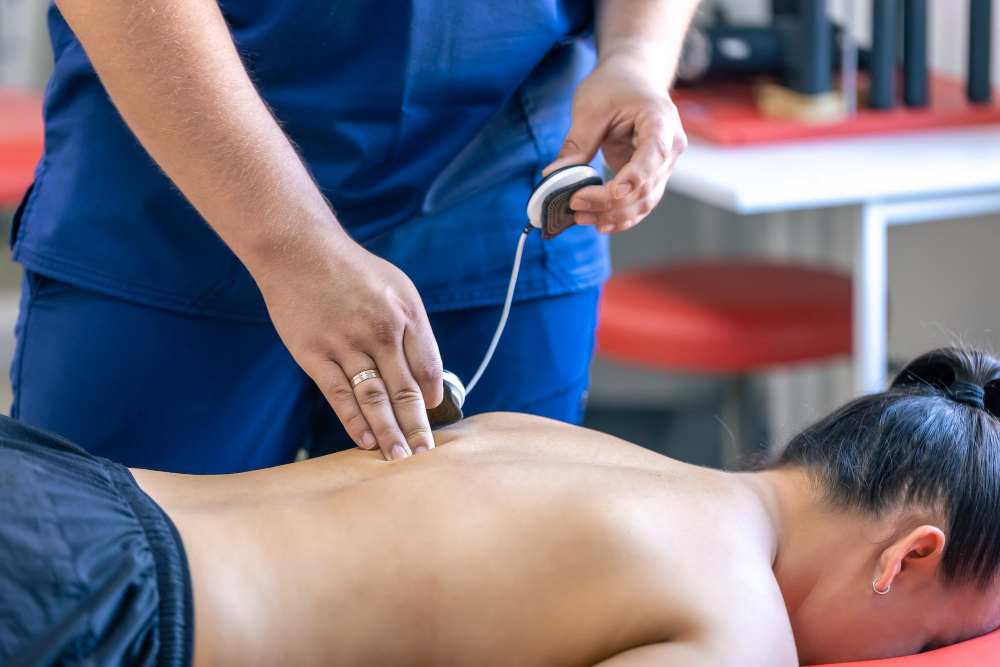The shoulder is a remarkable joint. It is where your upper arm, shoulder blade, and collarbone come together, helped by tendons and muscles called the shoulder capsule. Synovial fluid lubricates the capsule and the joints, helping everything to move smoothly. When healthy, your shoulder has a wider range of movements than any other part of the body.
Sometimes, your shoulder can become stiff and painful, with restricted range of movement. This is commonly known as a “frozen shoulder” (or more correctly “adhesive capsulitis”) and the resulting disability can be serious. A frozen shoulder injury affects 8.2% of men and 10.1% of women of working age. Left undiagnosed or untreated, the injury can slowly get worse over a period of years.
What causes a frozen shoulder?
A frozen shoulder occurs when the connective tissue surrounding the shoulder joint becomes inflamed and stiff. This creates tight bands called adhesions, and a reduction in synovial fluid, leading to pain and restricted motion.
There isn’t a clear cause for a frozen shoulder, though it is thought that those with diabetes or certain medical diseases related to the thyroid, could put someone at a greater risk. Historic shoulder injuries that have resulted in long periods of immobilisation may also trigger the issue.
The three stages of a frozen shoulder
The symptoms of a frozen shoulder usually develop slowly over time. It may start with an ache, rather than pain, possibly occurring during both day and night. The progression of a frozen shoulder can be broken down into three stages, which can help with diagnosis and treatment:

Stage 1 – the Freezing stage
The freezing stage is where the issue starts to arise. The shoulder becomes increasingly achy or painful, with range of motion becoming noticeably reduced. This can occur slowly over 3 to 6 months, so often is difficult to notice, as the symptoms only increase slowly. Pain may be most noticeable when you try to lift your arm away from your body. Movement loss may occur when you raise your arms or try to reach behind your back.
Stage 2 – the Frozen stage
The frozen stage may see a reduced level of overall general pain, however stiffness and a limited range of motion remain. Pain may still occur at the extremes of your shoulder’s movement.
Stage 3 – the Thawing stage
As you may have guessed, the thawing stage will see pain reducing and range of motion and strength returning to near normal, or pre-injury. This last stage may occur up to 2 years after the freezing stage started.
How to treat a frozen shoulder
If you are experiencing shoulder pain, then it is important to get it correctly diagnosed. A medical professional, such as a GP or qualified osteopath can help with this. If the pain or restriction in motion is severe, x-rays or scans may be required to check for dislocation, arthritis, or a rotator cuff tear.
Once a frozen shoulder has been established, treatment involves reducing the swelling and then to slowly increase the range of movement of the shoulder. Over the counter anti-inflammatory medication such as aspirin or ibuprofen can help, as can an ice pack or bag of frozen vegetables, applied to the shoulder for 10 to 15 minutes, several times a day.
When it comes to exercise, it is important to focus on gentle movements of the shoulder capsule that slowly increase the range of movement of the shoulder. Avoid activities that aggravate the pain. Always warm up your shoulder before performing your exercises, this can be done by taking a short bath or shower, or applying a warm heat pack to the shoulder.
Below are five simple exercises that can help. Always focus on ensuring the correct muscles and joints are being used, as your body will naturally try and protect the affected area and use alternative ways to move your arms! A qualified osteopath will be able to select the most effective exercises to help with your recovery, and show you how to do them correctly.
Five exercises to help treat a frozen shoulder
Pendulum stretch: This is the first exercise you should do as it both warms the area and gets the joints and muscles moving. Relaxing your shoulders, support yourself on a desk or chair and lean over slightly, allowing your affected arm to hang down freely. Move your body, so your arm swings in a small circle, 12 revolutions in each direction. It is important to let your arm swing free, like a pendulum
Towel Stretch: Hold a small towel behind your back in a horizontal position. Use your good arm to pull the affected arm upward, gently stretching it. If you are able, drape the towel over your good shoulder and use it to raise your affected arm vertically. Repeat up to 12 times, feeling a gentle stretch.
Finger walk: Stand about two feet from a wall. Keeping your elbow slightly bent, stretch your arm toward the wall and walk your fingers up the wall as high as you can. Your fingers should feel that they are doing the work. Use your good arm to help lower your affected arm, if required. Repeat up to 12 times, once or twice a day.
Crossover arm stretch: Sitting or standing, use your good arm to lift your affected arm at the elbow, bringing it up and across your body. Gently apply pressure to stretch the shoulder. Hold the stretch for around 15 seconds. Repeat up to 12 times.
Supine forward flexion: Lying on your back with your legs straight, use your good arm to lift your affected arm overhead until you feel a gentle stretch. Hold for 15 seconds, then slowly lower back to the start position. Repeat up to 12 times, giving your muscles time to recover between each repetition.

Shockwave therapy for Frozen shoulder
Shockwave therapy (or extracorporeal shockwave therapy, ESWT) is a proven treatment for tendon pain and is also effective for the treatment of a frozen shoulder. A 2022 systematic review and meta-analysis of Extracorporeal Shockwave Therapy as an Adjunctive Therapy for Frozen Shoulder, concluded:
“ESWT seems to be beneficial to patients with frozen shoulder by alleviating pain and improving function. ESWT could be used as an adjunct therapy to routine treatments.”
These findings are similar to those of a 2014 study which concluded:
“The use of ESWT seems to have positive effects on treatment, quicker return to daily activities, and quality-of-life improvement on frozen shoulder.”
A combined treatment regime involving both Shockwave therapy and osteopathy is likely to produce the best results.
How can Carl Todd Clinics help?
Carl Todd Clinics offer a range of treatments that can help relieve the pain of a frozen shoulder and put you on the road to a full recovery. We offer both Shockwave therapy and osteopathy, through experienced and qualified practitioners. If you think you might be suffering from a frozen shoulder, please get in touch so we can discuss a suitable treatment plan.





